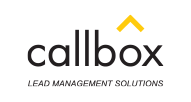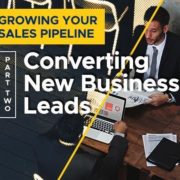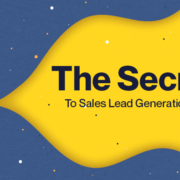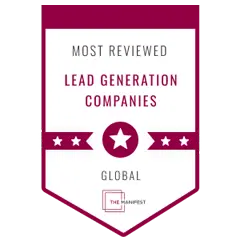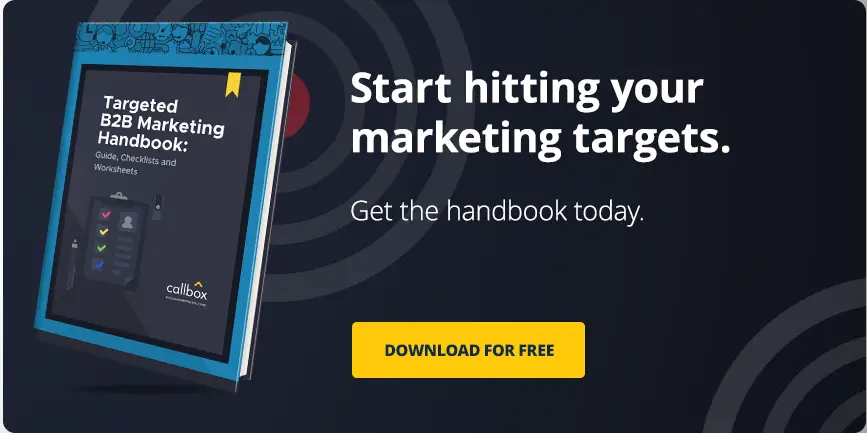Growing Your Sales Pipeline: Part 2 – Converting New Business Leads
In a another post, we went over a handful of sales prospecting tips that top-performing Australian B2B marketers put into practice. Today, we’ll focus on the next crucial step in achieving pipeline growth: converting new business leads into opportunities and customers.
To recap, recent research findings about the B2B marketing space in Australia (such as Green Hat’s 2018 B2B Marketing Report) reveal what highly-effective marketers tend to do differently. Based on these results, we’ve identified 10 pipeline growth strategies that drive the performance of best-in-class marketers:
- Document your marketing strategy the right way
- Work with TIDY marketing data
- Meet prospects where they actually are
- Focus on conversations, not just content
- Don’t do what everyone else is doing, unless…
- Always be selling the next step
- Help prospects find and use information faster
- Bake CX into your marketing DNA
- Separate the signal from the noise in your metrics
- Align, by all means, align
We’ve already talked about the first five points in detail in the previous post. We now turn our attention to the five other remaining pipeline growth ideas, which relate to lead conversion.
Always be selling the next step
Best-in-class marketers understand that today’s buying process is a marathon, not a sprint. That’s why they’re twice more likely to have a lead nurturing strategy and process in place compared to average marketers. Keep in mind that the most effective lead nurturing programs produce 50% more sales-ready leads at a 33% lower cost.
If you took the time to clearly document your lead generation strategy, then it’s going to be much easier for you to outline the steps in the nurturing process.
Marketing MO recommends going over these questions to define your buyer’s purchase journey (which you can then use to create your lead nurture path):
- When do buyers realize that they need help with a problem?
- What do buyers do to find potential solutions?
- How do buyers decide which solutions and vendors to evaluate further?
- What information do buyers need in order to make a decision?
- Who else from the buyer’s organization will be involved in the decision?
- How long will it take for the buyer to make a decision?
Help prospects find and use information faster
As B2B buyers control more and more of the purchase process, they need to quickly access the right information at the right time to help them move along the buying journey. Faced with an ocean of content and collaterals, buyers tend to prefer potential vendors that can help them easily find what they need.
Research from Aberdeen shows that targeting users with content relevant to their buying stage yields 72% higher conversion rates. At the same time, DemandGen Report finds that bundling lead nurturing content within a resource hub results in 400% increase in lead-to-pipeline ratio.
All this points to the fact that, not only does content need to be relevant to the buyer’s position along the purchase journey, it also needs to be easily within reach.
Here’s how to help prospects gain access to what they’re looking for:
- At each step in the purchase journey, what information or tool can you provide to help meet the needs of potential buyers?
- Can you assign persons from your team to be involved at each stage?
- Does your experience with past prospects help you identify how to shorten the time leads spend at each stage?
Bake CX into your marketing DNA
When it comes to converting new business leads, best-in-class marketers understand the value of optimizing customer experience (CX). In fact, this is a clear point of distinction between top-performing marketers and the rest of their peers.
According to Green Hat’s survey of Australian B2B marketers, around 48% of overall respondents have implemented customer journey mapping and developed personas, while 50% are targeting specific segments. By comparison, 67% of respondents classified as best-in-class have already undertaken customer journey mapping, and 74% are personalizing content.
Part of the reason for this difference in the level of CX focus is the multi-channel nature of the customer buying process. This is why a full 95% of B2B marketers find optimizing CX very challenging.
As PWC notes, buyers expect these four key qualities in any CX effort: speed, convenience, knowledgeable help, and friendliness. This is even more important now that 46% of B2B researchers and decision makers are millennials.
B2BMarketing.net lays out the specific steps in order to make CX a seamless part of your lead generation process:
- Audit your lead conversion process and set metrics for success at each touch point
- Plan for every stage in the customer life cycle, from acquisition to retention
- Make sure your marketing team (and only your marketing team) owns CX
- Get everyone’s buy-in and understanding
- Leverage influencers and customer champions
- Listen and respond to feedback
Separate the signal from the noise in your metrics
Highly effective marketers also excel at another crucial ability that their peers struggle with: measuring what matters.
As Bizible mentions, while both best-in-class and average marketers have largely the same marketing priorities, they differ in how they use marketing metrics. Top-performing marketers are 10% more likely to point to down-funnel metrics such as lead-to-opportunity, pipeline growth, revenue, ROI, etc. as gauges of their performance.
Best-in-class marketers are also more likely to claim they can reliably measure marketing results. Green Hat finds that 95% of top-performing marketers measure overall marketing ROI to some degree. In addition, almost 3 out of 4 highly effective marketers can accurately measure lead conversion and pipeline performance, 2 out of 3 can measure sales lead follow-up and more than half can measure campaign attribution.
One pressing reason why average marketers struggle with marketing measurement is that they tend to be inundated by an overwhelming amount of data. With so many data points to monitor and analyze, it can be hard to separate the signal from the noise.
An article from Forbes breaks down the steps to help you analyze marketing data more effectively:
- Start with clear objectives
- Assess the quality of data
- Answer specific questions
- Acknowledge and correct possible biases
- Analyze data in context
- Apply the right data visualization
- Organize and crunch the numbers using a reliable tool
- Assign the right person to the data analytics role
Align, by all means, align
Among the things we’ve mentioned so far, it’s the ability to align sales and marketing that starkly contrasts top-performing marketers with the rest of the pack.
Bizible uncovers a correlation between high marketing performance and marketing-sales alignment. Top-performing marketers are more likely to rate their sales-marketing alignment highly than average marketers.
Green Hat also observes a similar relationship between marketing performance and the degree of marketing-sales alignment. According to their study, sales-marketing alignment is the B2B area that sharply differs between best-in-class and average marketers.
Sales and marketing alignment is a core element of pipeline growth. With alignment, more leads are converted and followed up by sales, and both sales and marketing share a unified view of the prospect’s purchase process.
For alignment to happen, the following five areas need to be covered:
- Shared goals and KPIs
- Mutual lead management process
- Common lead definition
- Clear service-level agreements (SLAs)
- Open communications and regular collaboration
Conclusion: Now that we’ve seen what top-performing B2B marketers do to get the most from their marketing programs and campaigns, it’s time to put these ideas into practice. Building and growing your sales pipeline is all about finding the right approach to capture sales prospects and convert new business leads. Hopefully, the things we’ve covered in this series can point you toward that direction.
